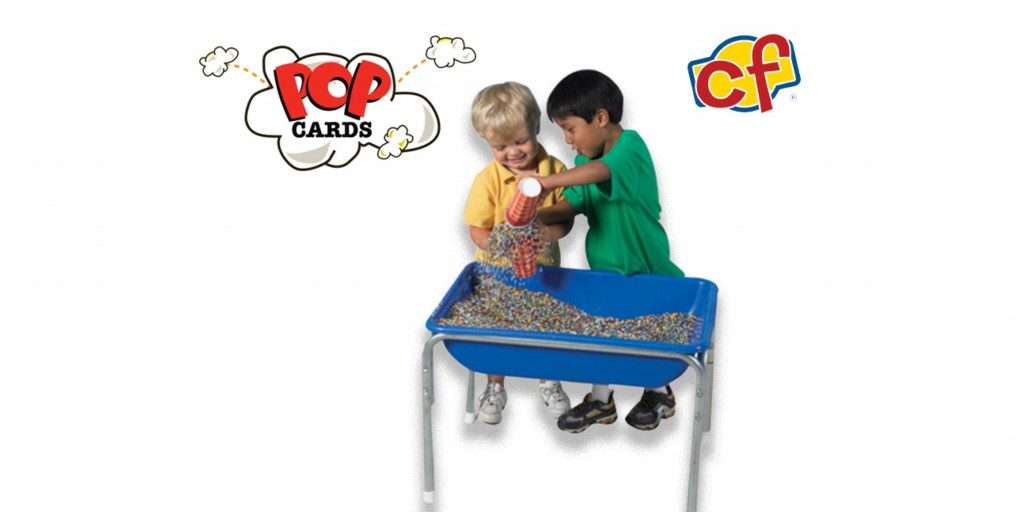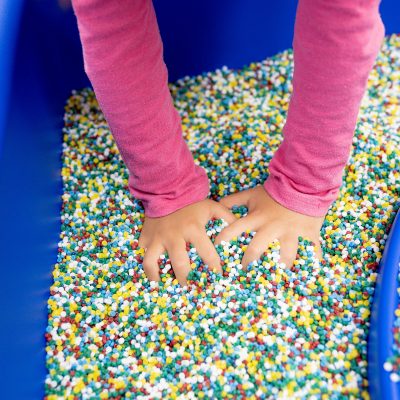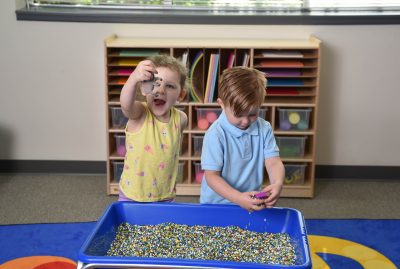
Lesson Plan ~ How Many Cups?
POWER OF PLAY (POP) – How Many Cups?

Kidfetti is a colorful twist to sand and water sensory play.
“Play is the essential ingredient, the vehicle by which children communicate, socialize, and learn about the world around them, understand themselves and others, deal with their problems, and practice some of the skills they will use in the future” (Hartley, 1971)
3 years + – Kidfetti – How Many Cups?
Environmental Set-up:
Children enjoy running their hands through the colorful Kidfetti, which is an ideal material for young children as it provides for tactile sensory-motor activities, is easily cleaned, and fun to use.
- Fill a clean tub or sand table with colored pellets (Kidfetti).
- Place six to eight different sized and shaped cups, along with pouring objects and utensils (e.g. spoons), in the tub or sand table.
- When children are first introduced to this new material, allow for free exploration with minimal adult guidance.
Objectives:
- Practice scooping and pouring
- Estimate amount of Kidfetti needed to fill different sized cups
- Predict which cups are smallest and which are largest
- Experience tactile sensation when running Kidfetti pellets through fingers and from hand to hand
- Practice fine motor skills in pouring and measuring
Activity Overview:
Place different cups and other tools in the tub of Kidfetti. Encourage children to experiment and play with the objects and the Kidfetti. Demonstrate handling the Kidfetti and pouring it from container to container.
Guiding Questions:

Our Small Sensory Table is perfect for kids 3 years and older.
Which cup do you think holds the most Kidfetti? Which cup holds the least or smallest amount? What happens when you pour Kidfetti from the big cup into the little cup?
Implications for Brain Development:
This activity provides the child with sensory-motor experiences of manipulating and experimenting with the Kidfetti. The sensory-motor experience of feeling, pouring, dumping, etc. leads to and is essential for cognitive discovery of size, shape, and quantity. Repetition of activities such as this strengthens and reinforces cognitive memory of the brain.
Developmental Learning Outcomes:
Sensory-Motor/Physical Development:
- Refining fine motor skills through use of measuring cups and pouring Kidfetti pellets from cup to cup
Cognitive Development:
- Estimation of size of cups and difference between cup sizes and shapes relative to how much Kidfetti will fit.
- Problem solving through proving which cups hold the most pellets and which cups the least amount
Language Development:
- Recognition of terms used in measuring (more, less, same)
- Communicating reasoning and findings to others
Social/Emotional Development:
- Sharing cups and Kidfetti with other children
- Success in proving hypothesis of largest and smallest
Activity Variation:
- Instead of cups, use measuring spoons with the Kidfetti
- Try to fill the measuring spoon using one color only
Resources:
Keenan, Sheila. (2001). What’s Up With That Cup? Cartwheel Publishing. Jackie Snider (Illustrator)
Rationale:
Young children enjoy learning to estimate and “proving” their hypothesis (guessing which holds the most or least) in a safe and low risk environment.
Play and investigation with the Kidfetti provides a colorful and engaging way to learn